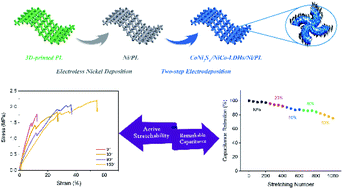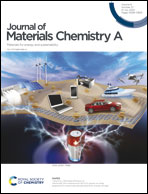A 3D-printed stretchable structural supercapacitor with active stretchability/flexibility and remarkable volumetric capacitance†
Abstract
With the rapid growth and advance in the Internet of things and flexible/on-skin electronics, stretchable/flexible energy storage devices are being unprecedentedly needed and widely pursued. However, it remains a great challenge to realize devices with both high storage capacity and satisfactory mechanical stretchability/flexibility. Herein, by synergistically combining 3D printing with electrodeposition, a 3D-printed stretchable structural supercapacitor with thick electrodes and a 3D Negative Poisson's Ratio (NPR) multicellular framework was developed. Benefiting from the well-designed NPR lattice electrode architecture and unique 3D nanoflower-on-nanosheet structured CoNi2S4/NiCo-LDHs nanocomposites, the assembled stretchable symmetric supercapacitor was highly stretchable (up to ∼55%) and flexible (up to 180°) with a favorable capacitance of 28.71 F cm−3, superior energy density of 0.582 mW h cm−3 and satisfied stability in stretching and bending cycles (75.2% of its initial capacitance after 1000 periodic stretch/release cycles), which are highly comparable to those obtained for previously reported stretchable supercapacitors. The strategy proposed here provides new insights in developing next-generation highly customized 3D structural strengthening energy storage devices for human–machine interfaces and real wearable and intelligent miniaturized electronics.



 Please wait while we load your content...
Please wait while we load your content...